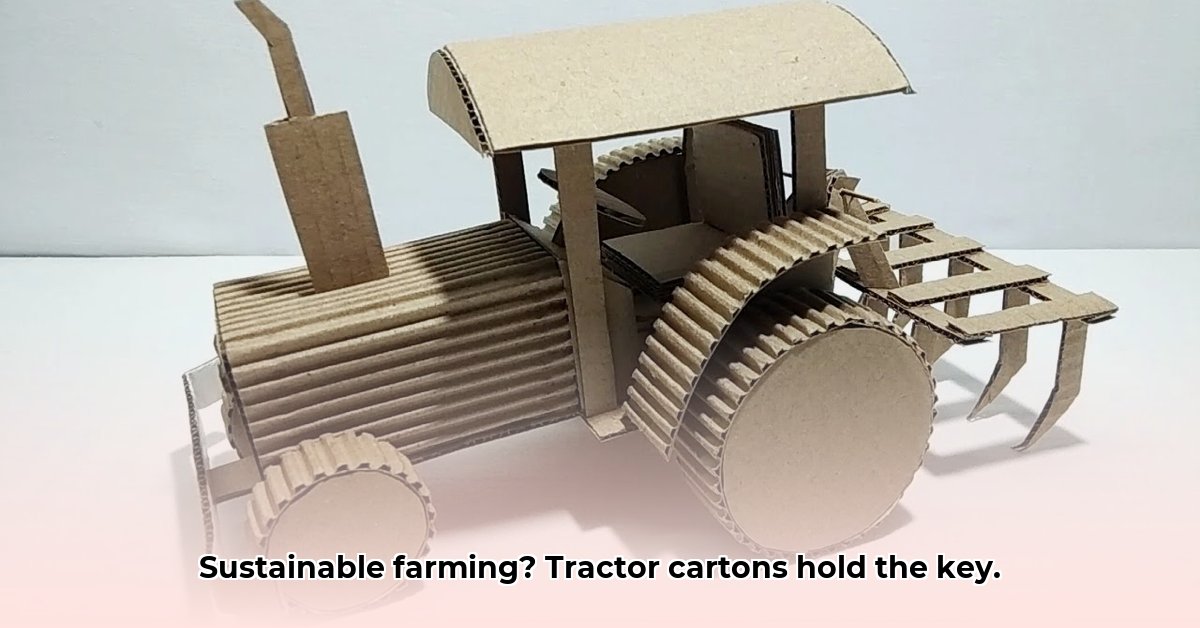
Tractor Cartons: Small Package, Big Impact on Sustainable Agriculture
Ever notice the brightly colored toy tractors in children's videos? These aren't just cute; they symbolize a larger shift toward sustainable farming practices. This article reveals how seemingly insignificant details, like a tractor's cardboard packaging—the tractor carton—can play a significant role in creating a greener future for agriculture. We'll explore how innovative packaging, along with other crucial practices, can contribute to a more sustainable and environmentally responsible farming industry. Isn't it remarkable how such small changes can create a substantial impact? For more on sustainable farming equipment, check out this resource.
Rethinking the Tractor Carton: From Waste to Resource
A new tractor arrives, gleaming and powerful, but its protective packaging often ends up in a landfill. But what if we viewed the tractor carton not as waste, but as an opportunity? Imagine cartons made from recycled and biodegradable materials, designed for easy reuse on the farm, and even repurposed after the tractor is safely installed. This shift in perspective could drastically reduce waste and environmental impact. How can we transform this often-overlooked packaging into a valuable resource? The answer lies in innovative design and commitment to sustainable practices.
Sustainable Farming: A Holistic Approach
Sustainable farming is more than just clever packaging; it's about resource efficiency and environmental protection. Precision agriculture—using GPS-guided tractors to plant seeds only where needed—saves fuel, reduces soil compaction, and minimizes environmental damage. This is where the tractor carton's role becomes even more significant. A well-designed carton protects the machinery, reducing the need for replacements and contributing to a broader sustainable approach—a win-win for the environment and farmers.
A Sustainable Future: Actionable Steps
Creating genuinely sustainable farming requires a multi-faceted approach. Here are some key areas for positive change:
Eco-Friendly Materials: Utilizing recycled cardboard or biodegradable materials for tractor cartons is a crucial first step. However, this requires environmentally responsible manufacturing processes, renewable energy sources, and a focus on minimizing the carbon footprint of the packaging itself. The manufacturing process must be sustainable to effectively reduce negative environmental impacts.
Smart Shipping and Logistics: Transporting heavy equipment is energy-intensive. Optimizing routes, using fuel-efficient vehicles, and designing cartons for efficient packing can significantly reduce the environmental impact. Consider the potential of reusable shipping containers, a common practice in other industries, to further minimize waste and fuel consumption. What are the most impactful choices we can make in transforming agricultural shipping?
Waste Reduction and Repurposing: Design tractor cartons for easy recycling or repurposing on the farm. This reduces landfill waste and minimizes environmental damage. Farmers could repurpose sturdy cardboard for temporary animal shelters or to separate crops during harvest. How can we maximize the versatility and usefulness of tractor cartons?
Enhanced Worker Safety: A well-designed carton improves the safety of workers handling and transporting tractors, reducing injury risks. Ergonomic design considerations can make the handling of the cartons less strenuous. What measures can we implement to ensure both worker safety and environmental sustainability?
Inspiring Future Farmers: A New Generation of Stewardship
Children's videos featuring tractors aren't just entertaining; they inspire the next generation of farmers. These videos highlight the excitement and technological advancements in agriculture, making the profession more appealing to young people. Cultivating a future generation that understands sustainable practices is paramount for ensuring the long-term health of our planet and the agricultural sector.
A Path to a Greener Agriculture: A Step-by-Step Plan
The tractor carton serves as a powerful symbol—a small piece of a larger puzzle. Building a sustainable agricultural future requires these crucial steps:
Invest in Research and Development: Invest in research to develop eco-friendly materials and designs for tractor cartons. This includes exploring different recycled materials and ensuring their strength and durability during shipping. The focus must be on innovation and sustainability in material science.
Foster Industry Collaboration: Agricultural equipment manufacturers and packaging companies need to collaborate on developing sustainable packaging options. This involves open communication and a sincere commitment to working together toward a common goal.
Enhance Education and Awareness: Raise awareness among farmers, consumers, and policymakers about sustainable packaging and its larger role in sustainable agriculture. This could involve educational campaigns, workshops, and partnerships with agricultural organizations. Knowledge permeates action, and sustainable agriculture requires informed stakeholders.
Implement Incentives and Regulations: Governments and organizations should incentivize farmers and manufacturers who adopt sustainable practices. This could include tax breaks, grants, or subsidies for eco-friendly packaging. Regulatory frameworks and financial support are vital in driving widespread adoption of sustainable practices.
The humble tractor carton exemplifies how even small details contribute significantly toward sustainability. By embracing sustainable practices and inspiring future generations, we can build a more responsible and productive agricultural sector. The journey towards a greener agriculture is a continuous process, and small, meaningful changes can have a significant impact.